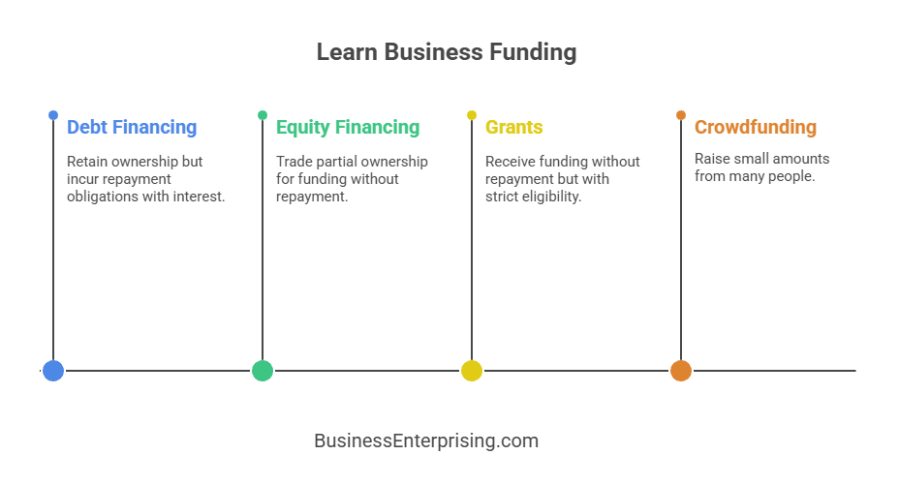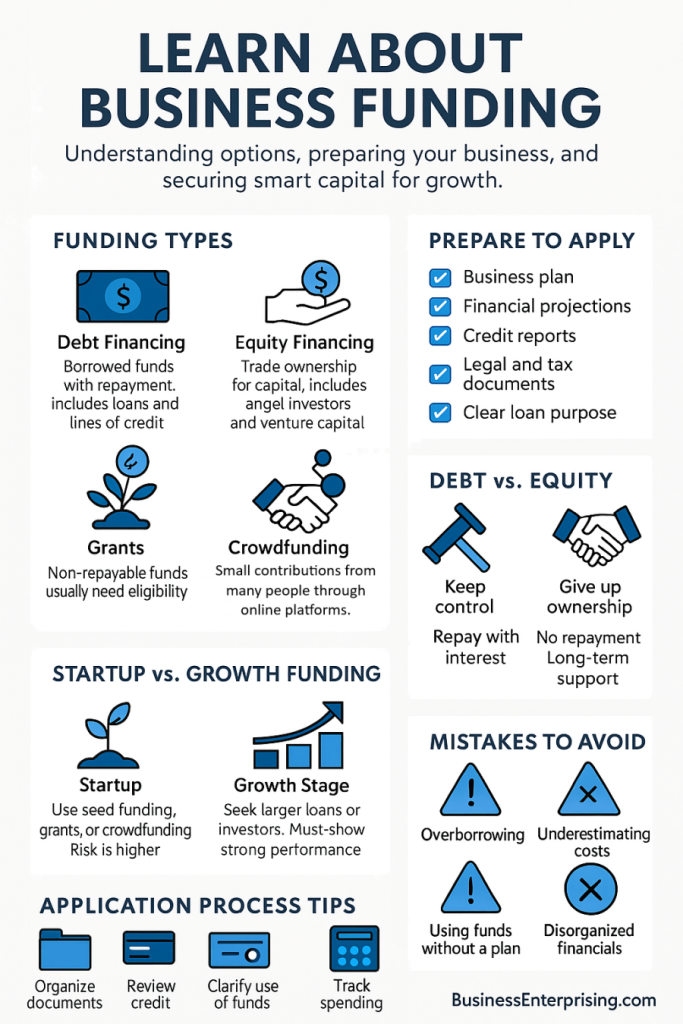 If you’re ready to grow your business, now is a good time to learn about business funding. Access to capital helps you start, operate, or expand. However, getting funding requires more than filling out an application. You need to understand the types of funding and how they work.
If you’re ready to grow your business, now is a good time to learn about business funding. Access to capital helps you start, operate, or expand. However, getting funding requires more than filling out an application. You need to understand the types of funding and how they work.
Different businesses have different needs. Some need short-term cash to cover expenses. Others want long-term capital to fuel growth. Therefore, the type of funding you choose should match your specific goals. Additionally, your business stage will affect your options. Startups and growth-stage companies often take different approaches.
Lenders and investors expect a clear picture of your business. They want to know how their money will be used. Therefore, you should be ready to share your plans, projections, and financial records. Having organized information improves your chances of getting approved.
Many business owners underestimate how long the process can take. However, the more prepared you are, the smoother things will go. Keep your documents up to date and understand your credit profile. These small steps can make a big difference.
Additionally, you need to avoid common mistakes that affect results. Borrowing too much, estimating too low, or lacking a plan can backfire. Being cautious upfront helps you stay on track. Funding can help or hurt depending on how it’s used.
The better informed you are, the better your decisions will be. Learn what works and avoid what doesn’t. The right approach to business funding can lead to real growth.
**Character count: 1,264** (including spaces)
Types of Business Funding Options
If you’re ready to learn about business funding, it’s helpful to understand the difference between debt and equity financing. Debt financing involves borrowing money that you repay over time, typically with interest. Loans and lines of credit fall into this category and are available through banks and online lenders. These options give you access to capital while allowing you to retain ownership of your business.
Equity financing, on the other hand, means trading partial ownership of your business for funding. Angel investors and venture capital firms provide this type of capital. In exchange, they often expect a return on their investment as your business grows. You won’t need to make monthly payments, but you do give up a share of control.
Additionally, grants can be a helpful option. They offer funding without repayment but often come with strict eligibility requirements. Most grants are awarded by government agencies or nonprofit organizations and may focus on specific industries or missions. Although they can be competitive, they’re worth pursuing when available.
Crowdfunding is another way to raise money. With this method, you ask many people to contribute smaller amounts. Platforms dedicated to crowdfunding make it easier to present your business and attract supporters. Crowdfunding can be used to pre-sell products, raise awareness, or gain early traction.
Each type of funding has different benefits and responsibilities. Think about your business goals before you decide. Some options may work better than others based on your current needs. By learning about different strategies, you’ll make more informed financial decisions. Taking time to learn about business funding can lead to stronger financial outcomes.
How to Prepare for Funding
Before you approach investors or lenders, you need to get your business documents in order. A clear business plan is essential. It should outline your goals, explain your product or service, and describe your target market. Without a solid plan, many funders will pass on the opportunity.
Additionally, make sure your financial projections are accurate and realistic. These should include income, expenses, and projected growth over the next few years. Most funders will expect to see how you plan to repay debt or generate returns. Therefore, your numbers need to support your business strategy.
Credit history also plays a part in the process. Many lenders review your personal and business credit scores. A higher score makes approval more likely and can lead to better terms. If your score is low, consider improving it before you apply.
Organizational readiness matters too. Investors and lenders want to know you can manage the money you receive. This means having proper accounting systems, clear roles for your team, and a business structure that supports growth. They want to see that your company can handle pressure and scale over time.
Preparing well takes effort, but it improves your odds. When you take time to review your materials and fix gaps, you send a strong message. You show that you’re serious and capable. Therefore, if you want to learn about business funding, preparation is one of the most important steps. A thoughtful and organized approach builds trust and helps you stand out.
Pros and Cons of Debt vs. Equity
When you learn about business funding, understanding the difference between debt and equity is important. Each one comes with its own tradeoffs. Debt gives you money that you must repay, usually with interest. Equity provides funding without repayment but requires you to give up ownership.
With debt, you keep full control of your business. However, you take on repayment obligations that can strain your cash flow. Monthly payments are expected regardless of your business performance. Therefore, you must plan carefully to meet those commitments. Interest costs can also add up over time.
Equity funding does not require repayment. Instead, you share ownership with investors. This can reduce financial pressure but may impact decision-making. Investors often want input on major moves. Although this adds support, it limits how freely you can run things. Additionally, giving away equity means sharing profits as well.
Growth potential differs with each option. Debt can speed up expansion if used wisely. However, it adds financial risk during slow periods. Equity allows for more flexibility and support but at the cost of partial control. You’ll need to weigh what matters more to you.
Think about your comfort with risk and how much control you want to keep. Also consider how quickly you need capital. Each path affects your business differently over time. Therefore, when you learn about business funding, take time to evaluate both types. Making the right choice depends on your goals and your financial situation.
Startup vs. Growth Stage Funding
When you learn about business funding, it helps to understand how funding needs shift as your company grows. Startups often need money to get off the ground. This includes funding for product development, early hires, marketing, and basic operations. Since there’s little or no revenue, many startups rely on personal savings, grants, or early-stage investors.
However, investors often take more risk in startups, which means they may want a bigger equity stake. Therefore, your ownership may shrink quickly in the beginning. Additionally, early-stage lenders may ask for personal guarantees since the business lacks credit history. Startups must show promise and a clear plan to attract funding.
Growth-stage companies usually need capital for expansion. This might include entering new markets, scaling production, or launching new products. Because revenue is often steady, these companies may qualify for larger loans or attract institutional investors. Banks are more likely to lend when the business has proven itself.
Therefore, your options improve as your business matures. However, expectations also rise. Investors and lenders want detailed financials, performance history, and clear strategies for scaling. Additionally, growth funding often involves higher amounts and longer commitments.
Think about what stage your business is in and how much risk you’re willing to take. Each stage comes with different funding paths. When you learn about business funding, knowing your stage helps you target the right sources and structure. This makes your funding efforts more efficient and productive.
Navigating the Application Process
When you learn about business funding, it’s helpful to understand how the application process works. Most funders require a structured and complete submission. You should start by gathering basic documents, including your business plan, tax returns, and financial projections. These items help lenders or investors evaluate your operation.
Additionally, prepare your personal and business credit reports. Many funders will review both during the screening process. If anything looks inaccurate, fix it early. Therefore, check your reports before applying. You can also include bank statements and proof of revenue to strengthen your file.
Each funder has slightly different requirements. However, most will want to see how you plan to use the money. Your loan purpose or funding request should be clear and realistic. Additionally, showing how you’ll repay or deliver returns builds trust.
You can improve approval odds by being responsive and prepared. Answer follow-up questions quickly and stay organized. Therefore, keep digital copies of all your documents ready to send. Responding quickly shows that you’re serious and dependable.
Some funders may request in-person or phone interviews. Use that time to explain your business and show confidence in your plan. Preparation helps you speak clearly and answer questions directly. Therefore, rehearse your key points ahead of time.
The application process takes effort, but it becomes easier with practice. When you learn about business funding, you realize how small details can affect outcomes. A complete, accurate, and timely submission increases your chances of success.
Avoiding Common Funding Mistakes
When you learn about business funding, you’ll want to avoid common mistakes that hurt long-term success. One major error is overborrowing. Taking on more debt than your business can handle puts pressure on your cash flow. Therefore, only borrow what you truly need and can afford to repay.
Additionally, many business owners underestimate expenses. This can lead to a shortfall even after receiving funding. Always build a buffer into your cost estimates. This makes your projections more accurate and helps avoid running out of money too soon.
Failing to align funding with a growth strategy is another frequent issue. You should connect every dollar to a specific goal. For example, don’t use loan funds for unrelated spending. Instead, stick to projects that drive growth or improve operations. A focused plan makes your funding more effective.
Some owners also skip the planning stage. However, taking time to outline how funds will be used helps you stay accountable. It also shows funders that you think long-term. Therefore, write down your spending plans before finalizing any deal.
Additionally, poor recordkeeping can create problems. If you don’t track how funds are used, it becomes harder to manage your financials. Clean records make reporting easier and support future funding requests.
When you learn about business funding, you’ll see that preparation matters. Thoughtful planning and discipline make the difference. Avoiding common mistakes protects your business and helps you get more value from the money you raise.
Conclusion
Taking time to learn about business funding can help you avoid costly mistakes and make smarter decisions. You don’t need to become a financial expert, but you do need to understand the basics. Every business has different funding needs, so the right solution depends on your situation.
Additionally, knowing the difference between debt and equity can shape how you grow. Each option has benefits and risks that affect your long-term direction. Therefore, think carefully about your goals before you choose a path. The wrong fit could slow progress or create pressure you don’t want.
Preparation also matters. Lenders and investors expect clear plans and accurate financials. They want to see that you can follow through. Therefore, take the time to organize your materials and improve your credit if needed. A strong application makes a better first impression.
Funding also needs structure. Use the money for planned goals and track results along the way. This approach keeps your finances in order. Additionally, it improves your chance of receiving support again later. Funders notice when you manage money well.
Mistakes like overborrowing or guessing costs can hurt growth. However, you can avoid most issues by thinking ahead. Review your numbers and double-check your strategy before applying.
If you want to grow your business without extra stress, planning is worth the effort. Learn about business funding early and revisit it often. You’ll make better choices and build a stronger foundation for the future. Patience, clarity, and discipline go a long way.



